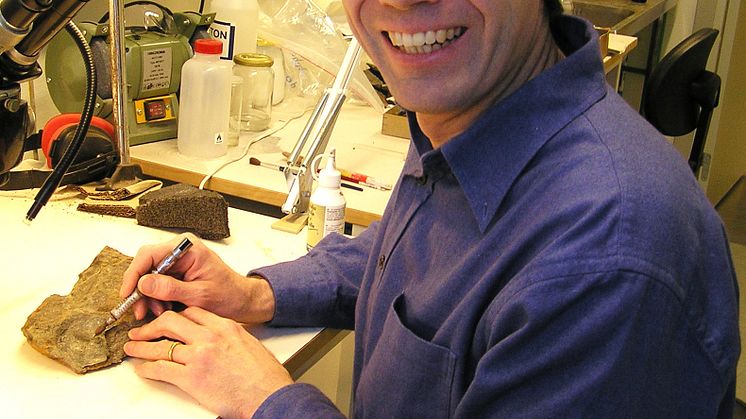Press release -
Jawed vertebrates get a face
This week in the leading journal Nature, a team of French and Swedish researchers present new fossil evidence for the origin of one of the most important and emotionally significant parts of our anatomy: the face. They show how a series of fossils, with a 410 million year old armoured fish called Romundina at its centre, documents the step-by-step assembly of the face during the evolutionary transition from jawless to jawed vertebrates.
Vertebrates (backboned animals) come in two basic models: jawless and jawed. Today, the only jawless vertebrates are lampreys and hagfishes, whereas jawed vertebrates number more than fifty thousand species, including ourselves. It is known that jawed vertebrates evolved from jawless ones, a dramatic anatomical transformation that effectively turned the face inside out.
In embryos of jawless vertebrates, blocks of tissue grow forward on either side of the brain, meeting in the midline at the front to create a big upper lip surrounding a single midline ”nostril” that lies just in front of the eyes. In jawed vertebrates, this same tissue grows forward in the midline under the brain, pushing between the left and right nasal sacs which open separately to the outside. This is why our face has two nostrils rather than a single big hole in the middle. The front part of the brain is also much longer in jawed vertebrates, with the result that our nose is positioned at the front of the face rather than far back between our eyes.
Until now, very little has been known about the intermediate steps of this strange transformation. This is where the skull of Romundina, an early placoderm (armoured fish with jaws) from arctic Canada stored in the collections of the Muséum national d'Histoire naturelle of Paris, comes in. Romundina has separate left and right nostrils, but they sit far back, behind an upper lip like that of a jawless vertebrate.
"This skull is a mix of primitive and modern features, making it an invaluable intermediate fossil between jawless and jawed vertebrates", says Vincent Dupret of Uppsala University, one of two lead authors of the study.
By imaging the internal structure of the skull using X-rays at the European Synchrotron Radiation Facility in Grenoble, France, the authors show that the skull housed a brain with a short front end, very similar to that of a jawless vertebrate.
"In effect, Romundina has the construction of a jawed vertebrate but the proportions of a jawless one", says Per Ahlberg, also at Uppsala University and the other lead author of the study; "this shows us that the organization of the major tissue blocks was the first thing to change, and that the shape of the head caught up afterwards".
By placing Romundina in a sequence of other fossil fishes, some more primitive and some more advanced, the authors are able to map out all the main steps of the transition, ending with the familiar kind of face that stares back at us all from the bathroom mirror every morning.
For more information, please contact:
Per Ahlberg, professor at the Department of Organismal Biology, Uppsala University tel: + 46 18-471 2641, e-mail: Per.Ahlberg@ebc.uu.se (speaks English and Swedish)
or
Vincent Dupret, researcher at the Department of Organismal Biology, Uppsala University, e-mail: vincent.dupret@ebc.uu.se Send an e-mail to set up a telephone interview. (speaks English and French)
Dupret et al. (2014) A primitive placoderm sheds light on the origin of the jawed vertebrate face, Nature, DOI: 10.1038/nature12980
Topics
Uppsala University -- quality, knowledge, and creativity since 1477
World-class research and outstanding education of global benefit to society, business, and culture.
Uppsala University is one of northern Europe's highest ranked academic institutions. www.uu.se





